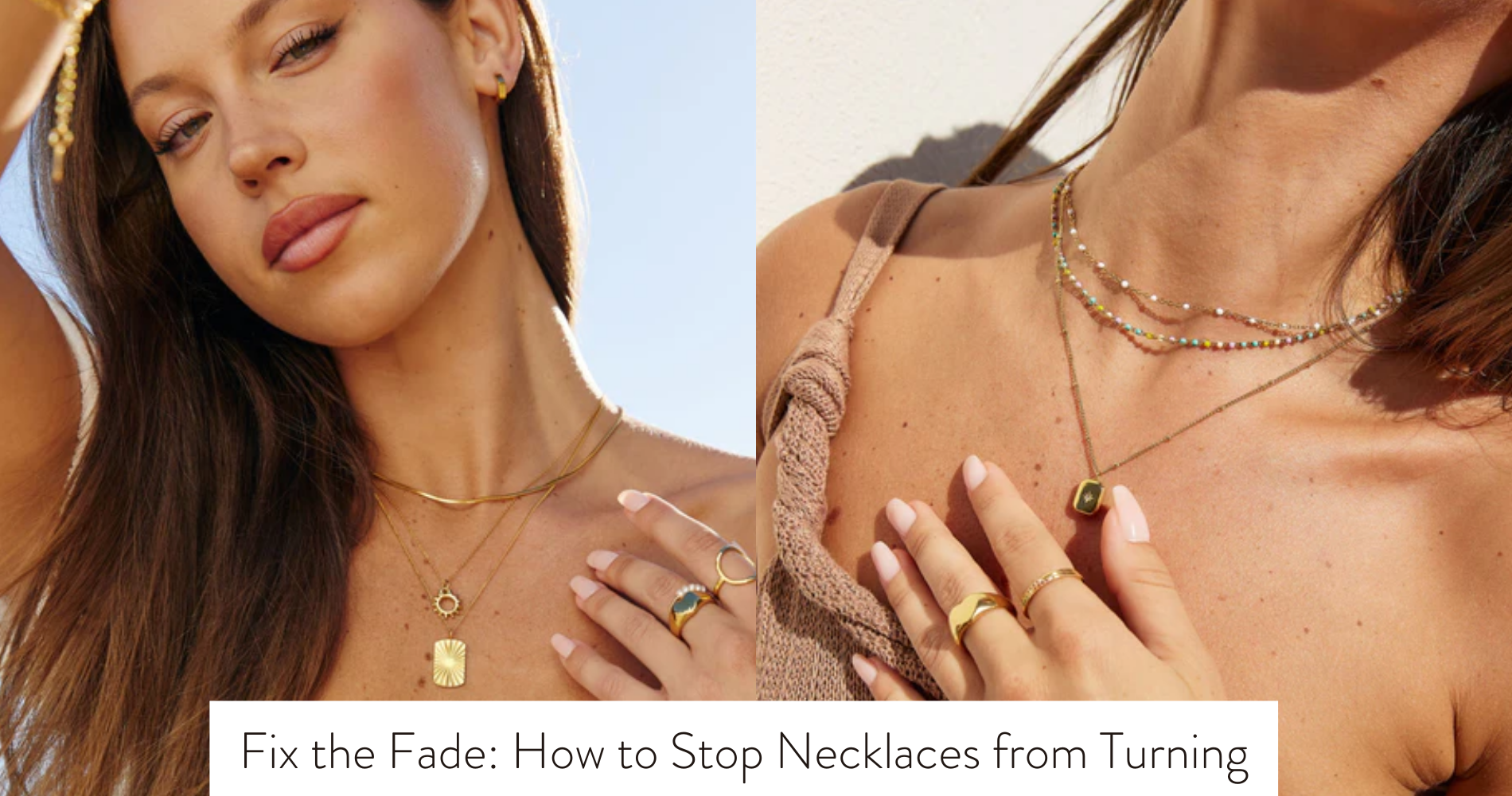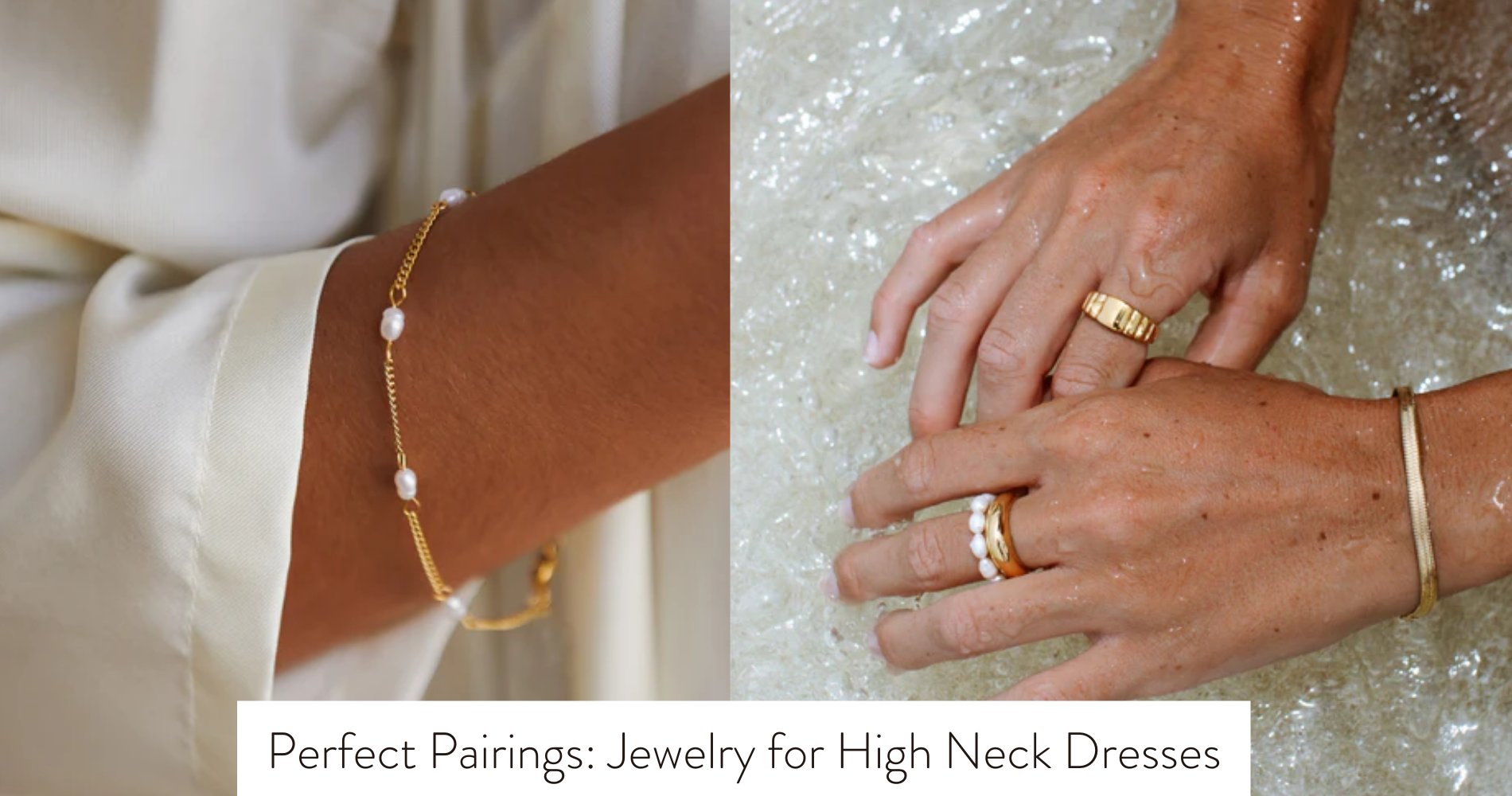
Fix the Fade: How to Stop Necklaces from Turning
Tired of untangling necklaces? Store them separately in soft pouches to prevent knots and damage. Using high-quality metals can significantly reduce the risk of tarnishing; however, for those seeking even more durability and ease of maintenance, our Waterproof Necklaces collection offers a brilliant solution. These pieces are designed to withstand exposure to water, making them ideal for everyday wear without the worry of tarnish or damage. Protecting your necklaces properly ensures they continue to add sparkle and style to your wardrobe for years to come.
Proper Storage Techniques
To prevent necklaces from turning, store them individually in soft pouches or compartments to avoid tangling. Proper necklace organization is key to preventing tangling and knot formation.
When traveling, consider using travel solutions like jewelry rolls or compact cases with separate compartments to keep each necklace secure and untangled. By storing each necklace separately, you reduce the risk of them getting intertwined and forming knots.
This method not only prevents tangling but also helps maintain the condition of your necklaces, ensuring they remain in good shape for a longer period. Taking the time to organize your necklaces properly will save you the hassle of untangling them later on.
Choosing the Right Materials
When it comes to preventing your necklaces from turning, the materials you choose play an important role. Opt for high-quality materials that can withstand everyday wear and tear, as durability matters greatly.
Consider how different materials may impact the longevity and appearance of your jewelry.
Material Impact
Selecting the appropriate materials can greatly impact the prevention of necklaces from turning while being worn.
Choosing high-quality metals, such as stainless steel or sterling silver, can help address the issue. These metals are less likely to bend or warp, keeping your necklace in place.
Furthermore, opting for materials that are treated to prevent oxidation can further prolong the lifespan of your jewelry. Oxidation is a common reason for discoloration and can result in the degradation of the metal over time.
Durability Matters
Materials play a crucial role in preventing necklaces from turning, and when it comes to durability, selecting the right materials is essential. To prevent tarnish and guarantee long term wearability, opt for high-quality metals like sterling silver, gold, or stainless steel. These materials are less likely to tarnish compared to others, keeping your necklaces looking shiny and new for longer periods.
Additionally, consider materials like titanium or platinum for even greater durability. These metals are known for their strength and resistance to corrosion, perfect for everyday wear. By choosing materials that are resistant to tarnishing and designed for long term wear, you can enjoy your necklaces without the worry of them losing their luster.
Cleaning and Maintenance Tips
To prevent your necklaces from turning, regularly clean them using a mild soap and water solution. Proper cleaning and maintenance are essential for preserving the appearance and quality of your jewelry.
Here are some tips to help you keep your necklaces in top condition:
- Polishing Techniques: Use a soft cloth to gently polish your necklaces after cleaning to restore their shine and remove any dullness that may develop over time.
- Tarnish Prevention: Store your necklaces in airtight containers or anti-tarnish bags to protect them from exposure to air, moisture, and other tarnishing agents that can cause discoloration.
- Preventing Breakage, Extending Lifespan: Avoid exposing your necklaces to harsh chemicals, extreme temperatures, or rough handling to prevent breakage and extend their lifespan.
Avoiding Harsh Chemicals
To prevent your necklaces from tarnishing, consider using chemical-free cleaning methods and adopting safe storage practices.
Harsh chemicals can damage the metal and gemstones, so opt for gentler alternatives like mild soap and water.
Additionally, store your necklaces in a dry and cool place to avoid exposure to harmful substances that could cause discoloration.
Chemical-Free Cleaning Methods
Wondering how to effectively clean your necklaces without harsh chemicals? Here are some chemical-free cleaning methods to keep your jewelry sparkling:
- Natural Remedies: Use gentle natural remedies like baking soda paste or vinegar to remove tarnish and dirt. Polishing cloths made from soft materials like microfiber can also help bring back the shine.
- Homemade Solutions: Create your own cleaning solutions using ingredients like mild dish soap and warm water. DIY techniques such as soaking your necklaces in a mixture of water and lemon juice can help restore their luster.
- Avoid Harsh Chemicals: Steer clear of harsh chemicals like bleach or ammonia, as they can damage the metal and gemstones in your necklaces. Opt for gentle, chemical-free alternatives for a safe and effective cleaning routine.
Safe Storage Practices
If you wish to guarantee the longevity and shine of your necklaces while avoiding harsh chemicals, proper storage practices are key. To prevent tarnishing and avoid tangling, follow these safe storage tips:
Adjusting Necklace Lengths
Adjust the length of your necklace by carefully sliding the clasp along the chain. Here are some key points to help you adjust your necklace length effectively:
- Chain Lengthening or Shortening: If you need to adjust the length of your necklace, you can easily do so by moving the clasp along the chain. For a shorter length, move the clasp closer to the center of the chain, and for a longer length, slide it towards the end.
- Clasp Types and Adjustments: Different types of clasps may require varying adjustments. Lobster clasps are common and can be moved easily, while spring ring clasps may need a bit more finesse. Magnetic clasps offer convenience but make sure they're secure when adjusting the length.
- Precision is Key: When adjusting the length of your necklace, make small increments to avoid tangling or damaging the chain. Take your time to make sure the clasp is secure after making any adjustments.
Utilizing Jewelry Organizers
To keep your necklaces organized and tangle-free, consider utilizing jewelry organizers to streamline your collection and make accessorizing effortless. Jewelry maintenance is essential for preserving the quality and longevity of your pieces. By investing in jewelry organizers such as wall-mounted racks, drawer inserts, or hanging organizers, you can effectively store your necklaces without the risk of tangling. These organizers provide separate compartments for each necklace, preventing them from getting intertwined and damaged. Necklace organization becomes a breeze when you can easily see all your options laid out neatly in front of you.
Moreover, jewelry organizers help you save time by allowing you to quickly find the perfect necklace to complement your outfit without rummaging through a tangled mess. This streamlined approach not only simplifies your daily routine but also prevents any unnecessary wear and tear on your necklaces. To summarize, utilizing jewelry organizers is a practical and efficient way to maintain your collection and make sure that your necklaces remain in pristine condition for years to come.
Regular Inspections and Repairs
Consider scheduling regular inspections and repairs to guarantee the continued quality and longevity of your necklaces. It's essential to take proactive steps in maintaining your jewelry to prevent any potential issues.
Here's how you can effectively ensure the durability of your necklaces:
- Inspecting jewelry: Regularly check your necklaces for any signs of wear and tear, such as loose clasps, missing stones, or weakened chains. Identifying problems early can help prevent further damage.
- Repairing damage: Address any issues promptly by seeking professional help for repairs. Whether it's fixing a broken chain or replacing a damaged pendant, timely repairs can prevent the problem from worsening.
- Maintaining cleanliness: Clean your necklaces regularly to remove dirt, oils, and other substances that can affect their appearance and condition. Use a gentle jewelry cleaner and a soft cloth to keep your necklaces looking their best.
Rotation and Alternation Strategy
Utilize a rotation and alternation strategy for your necklaces to prevent them from turning and guarantee even wear over time. By implementing a rotation strategy, you can make sure that all your necklaces are worn regularly, preventing one from being favored over the others. This helps distribute the wear and tear evenly, prolonging the life of your jewelry. Create a maintenance schedule where you plan which necklace to wear on specific days or occasions, ensuring each piece gets its fair share of use. Here is an example of how you can organize your rotation and alternation strategy:
Consulting a Professional Jeweler
If you're having issues with your necklaces turning, seek advice from a professional jeweler to address the problem effectively. A jeweler can provide expert guidance on how to prevent your necklaces from twisting and recommend suitable solutions tailored to your specific jewelry pieces. When consulting a professional jeweler, consider the following:
- Expert Assessment: A jeweler can assess the quality and design of your necklaces to identify any potential reasons for the twisting. They can offer valuable insights into the materials used, the clasp mechanisms, and other factors contributing to the issue.
- Custom Recommendations: Based on their assessment, a professional jeweler can recommend DIY fixes that you can implement at home to stop your necklaces from turning. These personalized solutions can help you maintain your jewelry collection in excellent condition.
- Preventive Measures: In addition to addressing the current problem, a jeweler can suggest preventive measures to avoid future necklace twisting. They may recommend storage techniques, cleaning methods, or adjustments to how you wear your necklaces to prevent rotation. Consulting a professional can provide long-lasting solutions for keeping your necklaces in place and looking their best.
Frequently Asked Questions
Can Wearing Certain Types of Clothing Contribute to Necklaces Turning or Fading?
Choosing the right fabric can help prevent necklaces from tarnishing or fading. Metal allergies may worsen with certain materials. Proper jewelry care, like storing pieces separately, can also extend their lifespan and keep them looking their best.
Are There Any Natural Remedies or DIY Solutions to Prevent Necklaces From Tarnishing?
To prevent tarnishing, try natural remedies like baking soda and water solution. Use DIY techniques such as cleaning with mild soap and warm water. Store necklaces in airtight containers or anti-tarnish bags to keep them shiny and fade-free.
How Can Humidity and Temperature Affect the Longevity of Necklaces?
Keep your necklaces safe by controlling humidity and temperature. Climate control is key for jewelry care. Opt for proper storage solutions and regular cleaning methods to maintain their longevity. Protect your precious pieces!
Can Certain Skin Types or Body Chemistry Affect How Quickly Necklaces Fade or Tarnish?
Certain skin types or metal allergies can speed up the fading or tarnishing of necklaces. Environmental factors like humidity and temperature may exacerbate this. To prevent this, consider opting for hypoallergenic metals and storing your jewelry properly.
Are There Any Specific Foods or Drinks That Should Be Avoided While Wearing Necklaces to Prevent Tarnishing?
To prevent tarnishing, avoid acidic foods and beverages while wearing necklaces. These can speed up the fading process. Follow jewelry care tips for prevention. Keep your pieces looking their best by being mindful of what you consume.
Conclusion
So there you have it - with a little care and attention, you can guarantee your necklaces from turning and keep them looking their best for years to come.
By following these simple tips and tricks, you can make sure that your favorite pieces stay in top condition and continue to add a touch of elegance to your outfits.
Remember, a little maintenance goes a long way in preserving the beauty of your jewelry collection.























Leave a comment
This site is protected by hCaptcha and the hCaptcha Privacy Policy and Terms of Service apply.